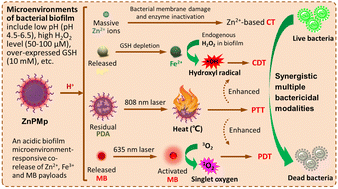A biofilm microenvironment-responsive one-for-all bactericidal nanoplatform for photothermal-augmented multimodal synergistic therapy of pathogenic bacterial biofilm infection†
Abstract
Multimodal synergistic bactericidal agents display great potential for fighting biofilm infections. However, the rational design of biofilm microenvironment (BME)-activatable therapeutic agents with excellent specificities, effective eradications and minimal side effects remains a great challenge. Herein, we show a BME-responsive one-for-all bactericidal nanoplatform consisting of Fe3+-doped polydopamine (Fe/PDA)-capped ZnO nanoparticles with a successive assembly of methylene blue (MB) and poly(ethylene glycol) (PEG). In an acidic BME (pH 5.5), the constructed nanoagent (ZnPMp) can realize the co-delivery of dual metal ions (Zn2+ and Fe3+) and MB, and the latter shows an activated photodynamic antibacterial activity when irradiated with 635 nm laser. Zn2+ produced from acid-sensitive dissolution of ZnO is an effective chemical antibacterial agent. Additionally, the released Fe3+ is reduced to Fe2+ by glutathione (GSH) overexpressed in the BME to generate Fe2+/Fe3+ redox couples, which exhibit Fenton catalytic activity to convert endogenous H2O2 to hydroxyl radicals (˙OH) for chemodynamic sterilization and GSH depletion ability to improve ˙OH-induced oxidative damage. Interestingly, the hyperthermia caused by the Fe/PDA layer assisted with 808 nm laser can damage directly bacterial cells, accelerate the release of Zn2+, Fe3+and MB, and promote the catalytic activity of Fe2+/Fe3+ redox couples for photothermal-augmented multimodal antibiofilm therapy. With the help of dual lasers, ZnPMp displays the broad-spectrum antibacterial effect, inhibits effectively the formation of biofilms, and more importantly eliminates bacteria deep in mature biofilms. In addition, ZnPMp can be used to treat biofilm-related infections in vivo with excellent therapeutic performance and minimal toxicity. Overall, the developed ZnPMp may serve as a potential nano-antibacterial agent for intensive anti-infective therapy.



 Please wait while we load your content...
Please wait while we load your content...